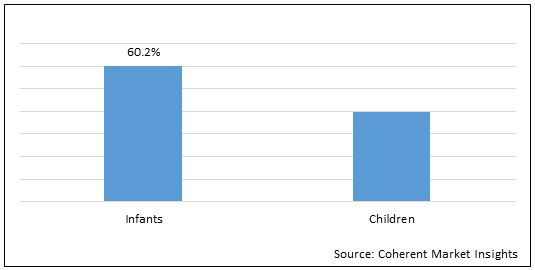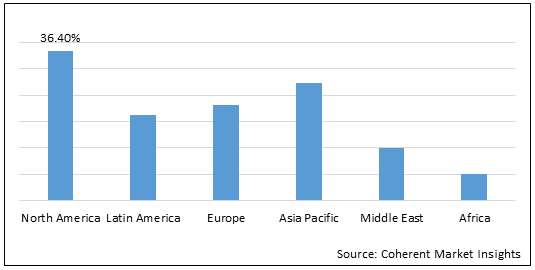Pediatric Nutrition Market is estimated to be valued at USD 4.49 Bn in 2025 and is expected to reach USD 6.93 Bn in 2032, exhibiting a compound annual growth rate (CAGR) of 6.4% from 2025 to 2032. These products are available in milk-based, soy-based, amino acid-based, and organic forms. These nutritional products support brain development and also help in the management of allergies and metabolic disorder. Highest number of births are recorded in Asia Pacific in year 2017, and hence, the region holds maximum opportunity for market players. Due to this, companies such as Mead Johnson Nutrition (acquired by Reckitt Benckiser Group plc), Nestle S.A., and Abbott are trying to maximize their market share in Asia Pacific, especially in China. High return on investments in this market is influencing large players to opt for inorganic methods of growth, as well as increasing the entry of new players in market. For instance, Reckitt Benckiser Group plc. acquired Mead Johnson Nutrition Company in June 2017.
Figure 1. Global Pediatric Nutrition Market Share (%), by Age Group

To learn more about this report, Request sample copy
Increasing demand for nutritional products in Asia Pacific is expected to boost growth of the pediatric nutrition market.
Increasing demand for nutritional products in Asia Pacific is expected to boost growth of the pediatric nutrition market. The rate of malnutrition is high in the Asian countries such as Afghanistan, Pakistan, and Indonesia. For instance, in August 2019, according to data published by United Nations International Children's Emergency Fund (UNICEF), Afghanistan has one of the world’s highest rates of stunting in children under the age of five, which is 41 per cent. Stunting is a sign of chronic under nutrition during the most critical periods of growth. It prevents children from reaching their potential increase immunity, adequate vitamins. Stunted children are more likely to contract diseases, less likely to get basic health care, and do not perform well in school. Chronic nutritional deficiency in Afghanistan is largely the result of the children eating the wrong types of food, in addition to not enough food. For example, only half of infants in Afghanistan are exclusively breastfed in their first six months, and their exposure to contaminated liquids or foods places them at a greater risk of life-threatening illnesses such as diarrhea and pneumonia. The rate of wasting, the extreme manifestation of severe acute malnutrition, in Afghanistan is extremely high at 9.5 per cent. Only half of infants in Afghanistan are exclusively breastfed in their first six months. Only 12 per cent of infants in Afghanistan aged 6-24 months receive the right variety of food in the quantity needed for their age.
Pediatric Nutrition Market Report Coverage
| Report Coverage | Details | ||
|---|---|---|---|
| Base Year: | 2024 | Market Size in 2025: | USD 4.49 Bn |
| Historical Data for: | 2020 To 2024 | Forecast Period: | 2025 To 2032 |
| Forecast Period 2025 to 2032 CAGR: | 6.4% | 2032 Value Projection: | USD 6.93 Bn |
| Geographies covered: |
|
||
| Segments covered: |
|
||
| Companies covered: |
Reckitt Benckiser Group Plc, Nestlé S.A., Abbott Laboratories, Groupe Danone, Royal FrieslandCampina, Baxter International Inc., Fresenius Kabi, and B. Braun Melsungen AG. |
||
| Growth Drivers: |
|
||
| Restraints & Challenges: |
|
||
Uncover macros and micros vetted on 75+ parameters: Get instant access to report
Figure 2.Global Pediatric Nutrition Market Share (%), by Region

To learn more about this report, Request sample copy
Innovative products for infants with special needs is boosting market growth.
Increasing research and development activities by key players in market for development of innovative products for infants with special needs is expected to drive the global pediatric nutrition market. For instance, in December 2021, according to an article published by World Health Organization, all infants should receive exclusive breast milk for the first 6 months of life. Human milk is a unique source of prebiotics and passive immunity for an infants. Continuing the legacy of supporting parents and clinicians by providing 100 percent human milk-based neonatal products, operations had been launched in the U.K. under the banner of NeoKare Nutrition. The founders of both the organizations, NeoLacta, NeoLacta Lifesciences, develops 100% human milk derived products and NeoKare, NeoKare Nutrition Ltd have an extensive background in human milk technology since they were instrumental in establishing the 1st milk bank in Australia. NeoLacta is the only human milk facility to have ISO clean rooms, Hazard Analysis Critical Control Points (HACCP) certified processes, onsite Research and Development, chemical and microbial labs and walk-in freezers, which distinguishes NeoLacta from any standard human milk bank.
Global Pediatric Nutrition Market– Impact of Coronavirus (COVID-19) Pandemic
Since the COVID-19 virus outbreak in December 2019, the disease has spread to over 100 countries across the globe and the World Health Organization had declared it a public health emergency on January 30, 2020.
COVID-19 has affected the economy in three main ways: by directly affecting production and demand of pediatric nutrition powders, by creating disruptions in distribution channels of pediatric foods. Due to nationwide lockdowns, several countries, such as China, India, Saudi Arabia, U.A.E., Egypt, and others, faced problems with regard to the transportation of pediatric nutrition powders from one place to another.
However, the COVID-19 pandemic had a negative impact on the global pediatric nutrition market, owing to disturbance in supply chain of pediatric nutrition supplements. For instance, in April 2020, International Food Policy and Research Institute (IFPRI), nutrition progress had been hampered by the COVID-19 crisis. To mitigate adverse nutrition impacts, they outline multisectoral nutrition actions that can protect the most vulnerable, including mothers and children. The COVID-19 economic crisis could also affect nutrition through disruptions in supply chains for nutrient-rich foods supplements such as probiotics, prebiotics, and pediatric nutrition powder. Agencies such as the United Nations International Children's Emergency Fund (UNICEF) were worried about disruptions to imports of crucial nutritional products, including micronutrient supplements and micronutrient-fortified products used to prevent and treat micronutrient deficiencies or severe acute malnutrition because of shutdowns and lockdown all over the world.
Moreover, for instance, in July 2020, according to World Health Organization, the perfect storm of eroded basic healthcare, chronic lack of access to safe water, sanitation, and hygiene (WASH), declining dietary quality, and heightened seasonal risk of infectious disease means that several millions of children in Asia and Africa were in danger of severe, life-threatening disease and malnutrition.
Global Pediatric Nutrition Market: Key Developments
On April 19 2022, Nutritional Growth Solutions, Ltd., (NGS, ASX: NGS) launches Healthy Heights KidzProtein and KidzProtein Vegan to support children’s development. The new product line includes 10 products: KidzProtein comes in chocolate, vanilla, and strawberry flavors; KidzProtein Vegan comes in chocolate and vanilla flavours. Nutritional Growth Solutions, Inc., Healthy Heights is a product of a health care system that believes it is the inherent right of every child to get right balnced vitamins, proteins, calcium, and minerals. KidzProtein and KidzProtein Vegan provide 10g of protein and a full array of vitamins and minerals.
Global Pediatric Nutrition Market: Restraint
The major factors that hinder growth of the global pediatric nutrition market include the manufacturing cost of pediatric nutrition products being slightly on the higher side. For instance, in November 2018, the U.S. Dietary Supplement Health and Education Act (DSHEA) established the regulatory framework for dietary supplements as foods through the Food and Drug Administration (FDA). Dietary Supplement Health and Education Act outlined the legal definition, labeling requirements, and process for adverse event reporting for dietary supplements. FDA also issued formal guidance on current Good Manufacturing Practice to ensure that processes for preparation, packaging, labeling, and storage of supplements and ingredients are documented and meet specifications to ensure purity, composition, and strength. The manufacturing cost of pediatric nutrition increases by following all regulations for manufacturing pediatric nutrition supplements.
Moreover, for instance, December 2021, NeoLacta Pasteurized Human Breast Milk (PHBM) was launched with higher cost as NeoLacta is the 1st and only company in India and Asia to have developed a state-of-the-art human milk processing facility with ISO 22000:2018 certification, GMP compliant and FSSAI approved. The cost of the product is high, owing to PHBM powder containing zero synthetic additives and can be reconstituted with recommended quantity of drinking water. The shelf-stable formulation of Pasteurized Human Breast Milk (PHBM) powder ensures storage at room temperature and avoids hassles of cold chain maintenance. All these processes to manufacture pasteurized human breast milk leads to high cost.
Key Players
Major players operating in the global pediatric nutrition market include Reckitt Benckiser Group Plc, Nestlé S.A., Abbott Laboratories, Groupe Danone, Royal FrieslandCampina, Baxter International Inc., Fresenius Kabi, and B. Braun Melsungen AG.
Share
Share
About Author
Vipul Patil is a dynamic management consultant with 6 years of dedicated experience in the pharmaceutical industry. Known for his analytical acumen and strategic insight, Vipul has successfully partnered with pharmaceutical companies to enhance operational efficiency, cross broader expansion, and navigate the complexities of distribution in markets with high revenue potential.
Missing comfort of reading report in your local language? Find your preferred language :
Transform your Strategy with Exclusive Trending Reports :
Frequently Asked Questions
Select a License Type
Credibility and Certifications

860519526

9001:2015
27001:2022


Joining thousands of companies around the world committed to making the Excellent Business Solutions.
View All Our Clients
US Reciprocal Tax Impact Analysis On Pediatric Nutrition Market
Stay updated on tariff changes with expert insights and timely information